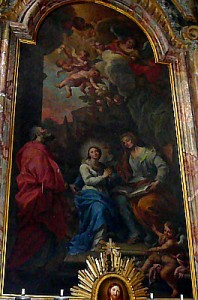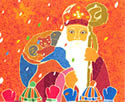
Today is Saint Anna’s day. You may know her as Jesus’s grandma, as Anna and Joachim were the parents of Mary. Anna is not a flashy saint. She’s no Mary Magdalene (hubba hubba!) or John the Baptist. But for people named Anna, she’s a patron saint. And there may be others who choose her as their patron as well, because they feel a special fondness for her, or were saved from a tragedy on her nameday (it’s sort of like a spiritual Big Brothers/Big Sisters mentoring kind of thing). She’s not my absolute favorite (that’s the Virign Mary), but I do have a soft spot for Anna, partly because of a wooden santos from Puerto Rico I was given by a dear friend, which depicts Anna reading to a child Mary. I love this image of her; a mom like any other, reading to a child, a commonplace event made exceptional because of the people involved and the tenderness of the moment.
Tuesday, December 6th, was St. Nicholas’s day. Now that’s a saint who’s a headliner, having been turned into Santa Claus because of his generosity. A fourth-century bishop in what is now Turkey, he was the original perpetrator of random acts of kindness, known for giving secret gifts to people, including throwing gold coins down the chimney (or through the window) of a poor man who had three dowryless daughters who would otherwise have had to follow the career path often ascribed to Mary Magdalene. (In the chimney version, the youngest daughter has hung her stockings in the fireplace to dry and the cash dropped right in, ka-ching! Thus stocking stuffers were born to the delight of retailers everywhere.)

![]()
 St. Nicholas is known as the patron saint of single women (there was a particular icon of him at Holy Trinity in New York I often venerated in the days before he sent me my beshert), thieves (not sure why, maybe it has to do with all the sneaking around chimneys), and fishermen (he’s often depicted saving sailors from shipwrecks and is sort of conflated with Poseidon in Greek folklore, maybe because of the beard, but that’s my own little theory). He was also the patron saint of an uncle-figure of mine, Themis, whose life was saved twice on St. Nicholas Day.
St. Nicholas is known as the patron saint of single women (there was a particular icon of him at Holy Trinity in New York I often venerated in the days before he sent me my beshert), thieves (not sure why, maybe it has to do with all the sneaking around chimneys), and fishermen (he’s often depicted saving sailors from shipwrecks and is sort of conflated with Poseidon in Greek folklore, maybe because of the beard, but that’s my own little theory). He was also the patron saint of an uncle-figure of mine, Themis, whose life was saved twice on St. Nicholas Day.
The first time, Themis was a 17–year-old policeman in Athens when the Nazis occupied the city and rounded up the entire police force in the station. Nature called and he excused himself. While in the bathroom, wondering what the Germans had in mind for the policemen, and sensing it wasn’t anything good, he noticed an open window. A skinny teenager, he climbed out the window, pulled himself up onto the rooftop and jumped from roof to roof of the neoclassical buildings in the Plaka neighborhood until he reached his own home, where he hid under the bed. The Nazis proceeded to march the policement to a nearby hill, shoot them, and leave their bodies in a ravine.
The second time, he was driving on a winding mountain road on St. Nicholas’ Day when he rode off the edge. The car flipped, but he was able to walk out of the twisted wreckage unscathed, leaving the car’s remains on the mountainside. Whenever I see a mangled auto carcass on the side of a mountain road in Greece (which is surprisingly often) I think of St Nicholas.
I know some would argue that these are tales of luck, and the date is coincidence; why would St. Nicholas choose Themis instead of all of the other policement or mountain drivers? But that’s the nature of patron saint relationship; they’re mystical and faith-based, they’re about feeling and belief not demonstrable knowledge. And above all, they’re personal, a connection between saint and supplicant and no one else.
I once wrote a paper for a nonfiction class that investigated an icon of the Saint Irene in Queens that was said to be crying (a not-unheard-of phenomenon among icons of female saints; some icons of male saints have been observed to emit a sweet myrrh-like scent, but there arren’t any cases of crying St. Nicks or his brethren, at least none of which I, and the priest I iterviewed for the paper, are aware). The priest I spoke with told me that he fears the furor over miracle-working saints or crying icons could detract from a worshipper’s belief in Christ Himself, which is the main event of Christianity. (Perhaps the multiplicity of saints feels too familiar to polytheism for this particular priest’s comfort.)
I see his point, but I sort of like the idea of having a personal relationship with a saint who looks out for you, one to whom you can confide your smaller problems when you don’t want to break out the big guns. Just like I like the idea of a saint who once read to her baby daughter before she grew up and became the Virgin Mary. I’m all for awe and wonder, the splendor of a cathedral. But I like my religion to have room for coziness too, the intimacy of a small chapel.
 That’s what I think Elizabeth Barrett Browning was referring to when she wrote that she loved Robert with “a love I seemed to lose/With my lost saints,” a love that mixes simple fondness with profound faith that someone is watching out for you.
That’s what I think Elizabeth Barrett Browning was referring to when she wrote that she loved Robert with “a love I seemed to lose/With my lost saints,” a love that mixes simple fondness with profound faith that someone is watching out for you.